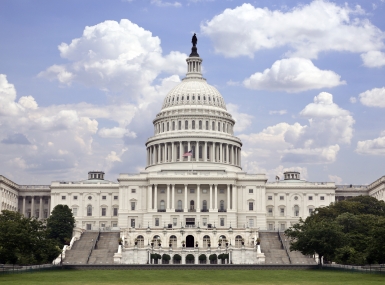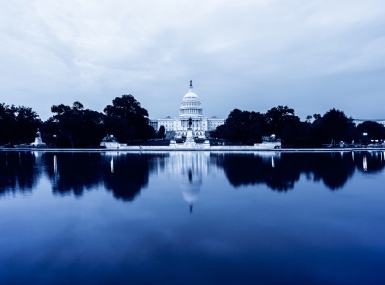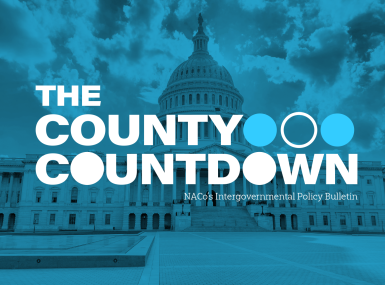Advocacy Toolkit: Counties and Tax Reform in 119th Congress

Jump to Section
On July 4, President Trump signed the sweeping budget reconciliation bill, the One Big Beautiful Bill Act (H.R.1), into law. Among several other key provisions impacting counties, the bill included a permanent extension of key provisions of the 2017 Tax Cuts and Jobs Act (TCJA). To see what other county provisions were included in the final reconciliation package, see NACo’s blog.
The provisions of the TCJA were set to expire on December 31, 2025, including several that directly impact county governments, our finances and the residents and communities we serve. NACo tracked the following tax provisions and advocated for county priorities such as the preservation of the municipal bond tax-exemption and the restoration of the state and location tax (SALT) deduction, among several others. See the below chart for details on the tax provisions in the initial proposal and the final bill signed into law.
| Tax provision | House Version (Initial Proposal) | Senate Version (Final Bill Signed into Law) | County Impact |
|---|---|---|---|
Tax- exempt status of municipal bonds |
Preserves the municipal bond tax exemption, avoiding a significant shift in infrastructure financing costs to state and local governments. |
Preserves the municipal bond tax exemption, avoiding a significant shift in infrastructure financing costs to state and local governments. |
NACo supports the ability of county governments to issue tax-exempt municipal bonds in order to build and maintain critical infrastructure at low cost to our residents. The tax-exempt status of municipal bonds was at risk of being eliminated or limited as a way to offset the overall cost of the package. Eliminating the tax-exempt status would have shifted $823 billion in new borrowing costs on state and local governments, or a tax and rate increase of $6,225 per U.S. household, over a decade. |
State and Local Tax (SALT) Deduction |
Permanently increases SALT cap to $40,000 for individuals making under $500,000 in modified adjusted gross income (MAGI), and $20,000 for married couples filing separately making under $250,000 in annual MAGI. Limits avoidance of the SALT cap by passthrough entities and S corporations and clarifies the list of taxes and payments that substitute for these taxes subject to the cap for these entities. |
Increases the SALT cap to $40,000 for individuals and joint filers making less than $500,00 per year in annual MAGI, and $40,400 in 2026 for individuals and joint filers making less than $505,000 in annual MAGI. For 2027 – 2029, both the cap and the income threshold would be 101 percent of the previous year’s amount. For 2025-2029 the cap would be reduced by 30 percent of the excess of the income threshold with a minimum SALT cap of $10,000. The cap would return to $10,000 with no income threshold or phase-out. |
NACo opposed the $10,000 cap on the SALT deduction since its enactment in 2017. Restoring the full SALT deduction is strongly tied to NACo’s long-standing national goal of promoting home ownership, as the overwhelming number of itemizers who claim SALT deduct property taxes and mortgage interest. Raising the SALT cap is a first step in restoring our federalist tax code and promoting fairness. To see how the SALT cap impacts your county, see our County Explorer resource here. |
Child Tax Credit (CTC) |
Expands the Child Tax Credit (CTC) from the current $2,000 level (under the 2017 Tax Cuts and Jobs Act expansion) to $2,500 until 2028 when it returns to $2,000. However, the bill requires both parents and all children to be a U.S. citizen and have a social security number. |
Permanently expands the Child Tax Credit from the current $2000 level to $2200. However, the bill requires both parents and all children to be U.S. citizens and have a social security number and does not address the credit’s phase in, preventing over 17 million children from low-income families from receiving the full credit. |
Income support like the CTC can have positive effects on children’s health, development, academic achievement, and long-term economic outcomes. By strengthening families’ economic security, the CTC can also reduce the need for more costly interventions in the health and human services systems. NACo supports structural changes to the CTC that increase the number of eligible households and provide higher benefit amounts. |
New Markets Tax Credit (NMTC) |
Does not extend the NMTC allowing it to expire at the end of calendar year 2025. |
Permanently extends the NMTC. |
NACo supports the permanent extension of the NMTC program in order to promote community development and economic growth by attracting private investment in low-income communities with high unemployment and poverty. While counties are not direct recipients of the NMTC, it is one of the critical economic development tools that allows private investments to spur economic growth in distressed communities. |
Low-income Housing Tax Credit (LIHTC) |
Expands the low-income housing tax credit, increasing the volume cap for the 9% LIHTC by 12.5% for 2026 – 2029. It also lowers the ‘tax-exempt’ financing threshold from 50% to 25% for projects placed into service after Dec. 31, 2025, and bonds issued before January 1, 2030. |
Permanently increases the volume of tax credits available for low-income housing by 12.5 percent and lowers the private activity bond financing required to access the credit from 50 percent to 25 percent beginning in 2026. |
While counties are not direct recipients of LIHTC, it is an important tool to stimulate private investment in the production of affordable housing, and NACo supports the permanent expansion of the LIHTC. The credit accounts for many of the new apartments constructed in the United States, and virtually all of the apartments constructed or rehabilitated for low-income renters. The permanent status of this tax credit will allow investors and housing providers to make appropriate investment |
Opportunity Zones (OZs) |
Establishes a second round of OZs, called “Opportunity Zones 2.0”, beginning on Jan. 1, 2027 through Dec. 31, 2033. Narrows the definition of “low-income community” to those with a 20% poverty rate or median family income less than 70% of the area median income and excludes census tracts with median family incomes 125% or greater than the area median income. Requires that 33% of all designated OZs are in exclusively rural areas and creates a rural qualified opportunity fund (RQOF) as an investment vehicle. Simplifies the investment incentives and provides a single liability reduction for investments in qualified opportunity funds (QOFs) held for 5 years that is tripled for investments in RQOFs. Includes reporting requirements for QOFs. |
Permanently extends the OZ program with census tracts being designated every 10 years beginning on Jan. 1, 2027. Narrows the definition of “low-income community” to those with a 20% poverty rate or median family income less than 70% of the area median income and excludes census tracts with median family incomes 125% or greater than the area median income. Eliminates the automatic eligibility for census tracts contiguous to low-income tracts. Establishes a rural qualified opportunity fund (RQOF) but does not require a certain amount of OZs to be located in rural areas. Maintains existing QOF investment incentives, but investments in RQOFs would receive triple the liability reduction benefit over the same schedule. Includes reporting requirements for QOFs. |
The Opportunity Zones program was established by the 2017 Tax Cuts and Jobs Act to promote economic growth in underserved communities by providing tax benefits to investors for making targeted investments in low-income census tracts designated by the Governor. Counties are not direct recipients of these tax benefits; however, we play a role in creating a supportive environment for business investment to meet our economic development goals. Many census tracts within our communities across the country have already been and could be designated in the future as eligible for targeted investment through this initiative. As the U.S. Department of Treasury develops guidance for Opportunity Zones 2.0, counties stand ready to work with our federal partners to ensure these investments can meet the needs of our communities. |
Inflation Reduction Act (IRA) Clean Energy Tax Credits & the Elective Pay Option |
Maintains the elective pay option for county governments but the credits that can be accessed through this opportunity are rolled back.
Expires on Dec. 31, 2025:
Gradual phase-out through Dec. 31, 2031 (20% reduction in 2029, 40% in 2030 and 60% in 2031)
Other Rollbacks
|
Maintains the elective pay option for county governments but the credits that can be accessed through this opportunity are rolled back.
|
The IRA expanded, extended and established new tax incentives to advance the development and deployment of clean energy and established the elective pay option that provided counties with the ability to access payments in the value of these clean energy tax credits for making eligible investments. While the elective pay option was not eliminated, counties will no longer be able to access certain credits for acquisitions and projects placed into service after their respective expiration date. Counties that plan to pursue the elective pay option for future planned investments could be impacted and should review enacted changes. |
Counties are BUILT BY BONDS
Tell Your County Story to Preserve the Tax-Exempt Status of Municipal Bonds
Share your county's story with us here to help elevate the importance of the tax-exempt status of municipal bonds as a critical local financing tool to Congress.
Explore SALT Profiles
Click here to access SALT profiles in a new window.
County Priorities for Tax Reform
America’s counties urge Congress to protect critical local financing tools and revenue streams critical to county operations. Additionally, we urge Congress to work to extend and strengthen key tax initiatives that support our residents, strengthen communities and boost economic growth.
County Authorities & Operations
Urge your members of Congress to preserve the tax-exempt status of municipal bonds
- Current Law: Interest earned on municipal bonds is exempt from federal taxes, meaning they are an attractive option for investors and generally issued at a lower yield, ultimately saving taxpayers money.
- Our Ask: Preserve the tax-exempt status of municipal bonds.
- Why: Municipal bonds are a critical infrastructure financing tool for counties that have helped finance over $3.3 trillion in infrastructure investments. More information here.
Urge your members of Congress to restore the tax-exempt status of advance refunding bonds
- Current Law: The 2017 tax law eliminated the tax-exempt status of municipal bonds. Currently interest earned on municipal bonds issued to advance refund a municipal bond is subject to federal income taxes.
- Our Ask: Reinstate the tax-exempt status of bonds issued to advance refund existing municipal bonds.
- Why: Municipal bonds are a critical local infrastructure financing tool that have financed over $3.4 trillion in infrastructure investments over a decade. The ability to advance refund saves local taxpayer money while also benefiting local communities. More information here.
Urge your members of Congress to modernize bank qualified debt by raising the small issuer threshold.
- Current Law: Entities issuing $10 million or less in bonds per calendar year are able to designate their bonds as “bank qualified” meaning they can be sold directly to local banks and bypass the traditional underwriting system – this is not adjusted for inflation and has not been adjusted since its establishment in 1986
- Our Ask: Raise the bank qualified debt threshold to $30 million and have it adjusted to inflation.
- Why: The ability to issue bank-qualified debt provides counties with access to the lower cost municipal debt we need to provide essential services and projects for our residents. Small issuers, including rural counties, typically save between an estimated 25 – 40 basis points per transaction, which ultimately saves counties and taxpayers a considerable amount of money when issuing these bonds. More information here.
Urge your members of Congress to restore the SALT deduction
- Current law: Prior to the Tax Cuts and Jobs Act, taxpayers had been fully deducting their already-paid state and local taxes since the foundation of the original tax code in 1913. The 2017 tax law capped the state and local tax (SALT) deduction at $10,000. Now individual taxpayers can only deduct $10,000 in a combination of property tax plus either income or sales tax, whereas businesses and landlords can access the full SALT deduction.
- Our Ask: Restore the SALT deduction by raising or eliminating the $10,000 cap.
- Why: Repealing the SALT cap would reverse the current double standard where businesses and landlords may deduct their state and local taxes, but individuals who achieve the American dream of homeownership are capped and held to a different standard. More information here.
Urge your members of Congress to preserve county financial authorities.
- Current Law: Counties can invest and borrow as we self-determine within the bounds of state and federal law and regulations. As fiduciaries of public funds, such as pension plans, we have the responsibility to have access to capital markets and make wise investment decisions.
- Our Ask: Preserve local decision-making authorities related to investing and borrowing pension and government funds.
- Why: Limiting the ability of counties to invest pension and government funds and to do business with certain institutions based on policies undermines county financial authorities and our fiduciary responsibilities and ultimately limits our access to capital markets.
Supporting Vulnerable Residents & Uplifting Our Communities
Urge your members of Congress to restore the Child Tax Credit (CTC) and make the credit fully refundable.
- Current Law: Under permanent law, taxpayers can claim up to $1,000 of the child tax credit (CTC) per child under age 17. Under the TCJA, the CTC was expanded to $2,000 per child under age 17, and income thresholds at which the CTC begins to phase out were increased from $75,000 to $200,000 for single parents, and $110,000 to $400,000 for married parents.
- Our Ask: Make the CTC fully refundable and restore the size of the credit to previous levels authorized under ARPA.
- Why: Income supports like the CTC can have positive effects on children’s health, development, academic achievement, and long-term economic outcomes. By strengthening families’ economic security, the CTC can also reduce the need for more costly interventions in the health and human services systems.
Urge your member of Congress to restore the Child and Dependent Care Tax Credit (CDCTC).
- Current Law: The Child and Dependent Care Tax Credit (CDCTC) is a nonrefundable tax credit based on child and dependent care expenses. The CDCTC is calculated by multiplying qualifying expenses ($3,000 for one child, $6,000 for two or more) by the appropriate credit rate, which is determined by the taxpayer’s income. In 2021, the CDCTC was temporarily expanded for one year under the American Rescue Plan Act (ARPA). The maximum qualifying expenses were adjusted to $8,000 for one child and $16,000 for two or more children, the credit became fully refundable, the credit rate was increased, and a phase-out for families with an income above $400,000 was implemented.
- Our Ask: Adjust the CDCTC for inflation and restore the credit’s refundability that expired in 2021.
- Why: The CDCTC is the only tax credit designed to explicitly help parents offset child care expenses, however, the average family receives approximately $600 a year, which does not even cover one month of child care costs for the majority of families. Since 2000, when the CDCTC was last updated, the cost of child care has increased by 223 percent, making the impact of the credit far less effective.
Urge your members of Congress to strengthen the Low-Income Housing Tax Credit (LIHTC).
- Current Law: The Low-Income Housing Tax Credit (LIHTC) provides roughly $10 billion annually in budget authority to State and local LIHTC-allocating agencies to issue tax credits for the acquisition, construction, and rehabilitation of affordable rental housing for low- and moderate-income tenants.
- Our Ask: Restore the 12.5 percent cap increase that expired in 2021; increase the annual credit allocation by 50 percent; lower the financing threshold of Private Activity Bond from 50 to 25 percent; and streamline program rules to align the credit with other affordable housing programs.
- Why: In the midst of the nation’s worst housing crisis, it's the largest federal program for the production and preservation of affordable rental housing — accounting for virtually all apartments constructed or rehabilitated for low-income renters. More information is available here.
Urge your members of Congress to permanently extend the New Markets Tax Credit.
- Current Law: The New Markets Tax Credit permits individual and corporate investors to receive a tax credit against their federal income tax in exchange for making equity investments in low-income communities through specialized financial intermediaries called Community Development Entities (CDEs) — the credit totals 39 percent of the original investment amount and is claimed over a period of seven years.
- Our Ask: Permanent extension of the credit, which is set to expire at the end of 2025.
- Why: It is an indispensable tool which helps incentivize private investment in underserved communities, fostering job creation and revitalizing local economies.
Urge your members of Congress to establish the Single-Family Homeownership Tax Credit.
- Current Law: There currently is no credit to support the development of single-family affordable housing units.
- Our Ask: Creation of an investor-based tax credit that would encourage the development of single-family affordable housing for low and moderate-income households.
- Why: Construction of new housing units has not kept pace to meet demand; the housing stock — the total number of housing units — has remained largely unchanged since 1980, putting the dream of homeownership out of reach for man families. By incentivizing the construction of new affordable homes, more families will become homeowners, thus giving them a stake in their communities and increasing the stability and vitality of neighborhoods.
Urge your members of Congress to restore the expanded Earned Income Tax Credit (EITC) eligibility.
- Current Law: The federal Earned Income Tax Credit (EITC) is a refundable tax credit primarily for low- and moderate-income workers. The credit is calculated by individual's earnings, marital status, and number of qualifying children, providing a significantly lower credit for workers without children. The ARPA temporarily expanded eligibility and increased the maximum credit of the EITC for workers without children.
- Our Ask: Restore the expanded age of EITC eligibility and benefit amount for childless workers that expired in 2021
- Why: As seen in 2021 under its expansion through ARPA, the EITC can be an important antipoverty tool. However, in its current form, the EITC provides limited help to millions of working adults who do not have children. Furthermore, the age restrictions on childless workers (must be between ages 25-64) to qualify for the EITC are not imposed on families with children.
Urge your members of Congress to preserve Medicaid Disproportionate Share Hospital (DSH) payments
- Current Law: Federal law mandates that state Medicaid programs provide Disproportionate Share Hospital (DSH) payments to hospitals that serve a significant number of Medicaid and uninsured patients. Each state is allocated an annual DSH allotment, which sets a cap on the Federal Financial Participation (FFP) for total statewide DSH payments. In addition to this statewide limit, there is also a hospital-specific DSH cap, which restricts FFP to the amount of uncompensated care costs incurred by each hospital. Currently, the Medicaid DSH reductions are to begin in Fiscal Year (FY) 2025 and last until FY 2027 with aggregate reductions to the Medicaid DSH allotments equal to $8.0 billion for each of those years.
- Our Ask: Maintain current DHS payments by delaying the implementation of DSH payments reductions and reducing the reduction amounts.
- Why: Maintaining DSH payments is critical for county-supported hospitals, especially since they serve as providers of last resort, offering care to all patients regardless of their ability to pay. With over 900 county-supported hospitals, two-thirds of which are located in rural or small counties, these facilities play a vital role in their communities. While Medicaid reimbursement often falls short of covering the full cost of services, it remains a crucial revenue stream for these hospitals. To help offset revenue losses, the federal government provides these critical DSH payments to hospitals that care for a disproportionately large number of Medicaid beneficiaries, ensuring these institutions can continue to serve vulnerable populations.






